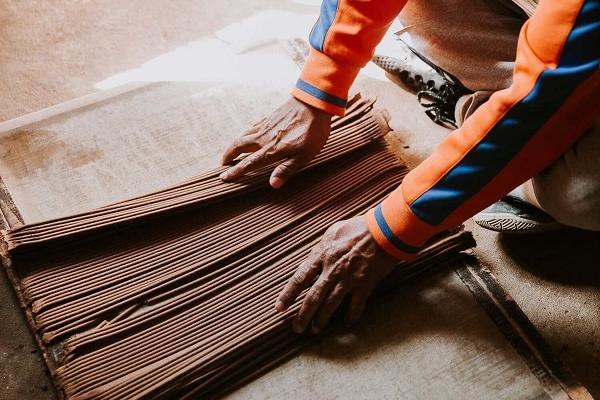Rope incense, often referred to as Tibetan incense, is a special kind of incense from Tibet, northern Nepal, and Bhutan, and it captures the spirit of Tibetan culture. Its earthy and herbal scent gives you a wonderful sensory experience, connecting you to tradition. This unique incense is made with care and typically includes 30 or more natural ingredients, highlighting the wisdom found in nature. Instead of the usual stick form, Tibetan incense is shaped into lengths or coils, showcasing its distinctive craftsmanship. In Nepali, it’s known as bateko dhoop, and it beautifully ties us to the rich history of incense-making.

Tibetan Incense Burner
History of Tibetan Incense
Incense has a rich history in Tibet and is believed to have been introduced in India approximately 1,300 years ago. This ancient aromatic practice is rooted in texts nearly 2,000 years old detailing the art of crafting various forms of incense. The Bon religion, which predates the arrival of Buddhism in Tibet, also incorporates the tradition of smoke offerings, signifying a deep cultural and spiritual connection to aromatic substances.
In Buddhist teachings, it is said that the Buddha Shakyamuni pioneered the creation of incense sticks. He imparted this knowledge to his disciples, explaining the significance of incense in spiritual practices and rituals. Burning incense in Buddhism is often seen as a form of offering, representing purity and tranquility, which seeks to create a conducive environment for meditation and prayer.
Over the centuries, numerous monasteries and revered Buddhist teachers have developed distinct recipes for Tibetan incense. These unique blends are artfully composed using various natural ingredients, including herbs, fragrant woods, aromatic spices, and aromatic resins. The meticulous crafting process reflects the spiritual intentions behind their use and the rich biodiversity of the Himalayan region, where many of these ingredients are sourced. Each type of Tibetan incense serves its purpose, whether for meditation, healing, or ceremonial use, illustrating the intricate relationship between culture, spirituality, and natural elements in Tibetan life.

Tibetan Incense Powder
Medicine of Tibetan Incense
In Tibetan medicine, incense is believed to help treat various health issues. This idea is mentioned in traditional Tibetan medical texts, which come from a collection known as the four Tantras. These texts form the foundation for modern Tibetan medicine.
According to Tibetan medical beliefs, everything in the universe comprises five basic elements: earth, water, fire, air, and space. However, when it comes to understanding illnesses, only four components are considered relevant; space is not included. Each component has specific features and qualities that can influence our health.
These elements are also connected to three types of energies within our bodies, and when these energies become unbalanced, they can disrupt the harmony of our bodily functions.

Tibetan Incense Making Process
Production of Tibetan Incense
Authentic Tibetan incense is crafted according to traditional recipes passed down through generations in monasteries and medical colleges. Its rich history dates back to its original creators, who utilized these ancient formulations for spiritual and medicinal purposes. However, as time has progressed, the production of Tibetan incense has become increasingly commercialized. This shift has resulted in a proliferation of manufacturers who often need to adhere to the original methods, leading to a diluted quality and a departure from the traditional craftsmanship central to Tibetan culture.
Today, most Tibetan incense is produced in small artisan workshops, where each piece is made with meticulous attention to detail. The process begins with carefully selecting various natural ingredients, including herbs, spices, and plant materials. These ingredients are ground into a fine powder, often using traditional stone mortars or grinders. Once the powders are prepared, they are combined with water to form a pliable dough. This dough is then shaped by hand into sticks or coils, a practice that requires skill and precision. After shaping, the incense is left to air dry naturally, allowing the fragrances to develop fully.
Every step of this intricate process is performed by skilled artisans who take great pride in their work. They ensure that each piece of incense carries the essence of Tibetan culture and tradition. It is also noteworthy that traditional Tibetan incense does not incorporate essential oils or complex synthetic blends; instead, it relies solely on the natural aromas of the ingredients used, which are believed to enhance meditation and spiritual practices. This authenticity not only preserves the cultural significance of Tibetan incense but also promotes a deeper connection to its historical roots.

Tibetan Incense Mugwort
Benefits of Tibetan Incense
Tibetan incense is more than just a nice smell; it’s a key part of Tibetan cultural and spiritual traditions. Burning incense is considered sacred, almost like making an offering to the divine. This ritual helps create a peaceful atmosphere ideal for meditation and prayer. People believe that the fragrant smoke carries their prayers and intentions upward, connecting them with higher powers and inviting good vibes into their space.
Regarding its medicinal qualities, the ingredients used in Tibetan incense are carefully chosen for their healing benefits. For example, sandalwood is known for its calming effects, making it a great choice for anyone relaxing during meditation. Juniper is also popular, as it’s thought to cleanse the area of negative energy and bring in uplifting, positive energy.
Many people enjoy using Tibetan incense in their daily lives as a natural way to relieve stress, improve focus, and promote overall well-being. The soothing scents can create a calming environment, helping with relaxation and clarity. So, Tibetan incense serves spiritual purposes and supports mental and emotional health in our everyday lives. Tibetan incense remains a beloved part of holistic living through its beautiful fragrance and rich traditions.










